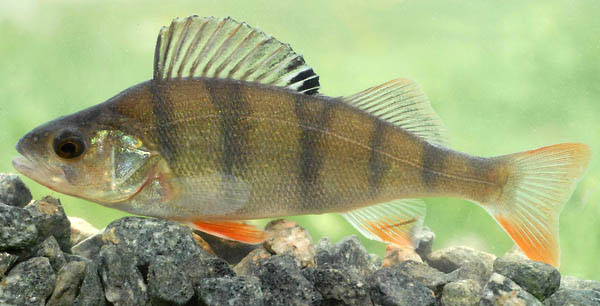| Percidae (Perches), subfamily: Percinae |
| 60 cm SL (male/unsexed); max.weight: 4,750.0 g; max. reported age: 22 years |
|
demersal; freshwater; brackish; pH range: 7 - 7.5; dH range: 8 - 12; depth range 1 - 30 m, anadromous |
| Eurasia: throughout Europe to northernmost extremity of Scandinavia, except Iberian Peninsula, central Italy, and Adriatic basin; Aegean Sea basin in Matriza and from Struma to Aliakmon drainages; Aral Sea basin; Siberia in rivers draining the Arctic Ocean eastward to Kolyma. Widely introduced. Several countries report adverse ecological impact after introduction. |
|
Dorsal spines (total): 14-20; Dorsal soft rays (total): 13-16; Anal spines: 2-2; Anal soft rays: 7-10; Vertebrae: 39-42. Diagnosed from other species of Percidae in Europe by having the following unique characters: pelvic and anal fins yellow to red; posterior part of first dorsal fin with dark blotch; and flank with 5-8 bold dark bars, usually Y-shaped. Differs further by the combination of the following features: two dorsal fins, clearly separated from each other; and 56-77 scales along lateral line (Ref. 59043). Body greenish-yellow; 5-9 transverse black bands on the sides; first dorsal fin gray, black spot at the tip; second dorsal greenish-yellow; pectorals yellow; other fins red. First dorsal fin markedly higher than the second. Caudal fin emarginate (Ref. 2058). |
| Inhabits a very wide range of habitats from estuarine lagoons, lakes of all types to medium-sized streams. Feeding larvae occur in open water. This is an opportunistic diurnal feeder which preys mainly during sunrise and sunset, using all available prey. Larvae and small juveniles usually feed on planktonic invertebrates. During first summer, many juveniles move near shores to feed on benthic prey. Often feeds on fishes at about 12 cm SL. May undertake short spawning migrations. Males attain first sexual maturity at 1-2 years and females at 2-4 years of age. Spawns in February-July (Ref. 59043). Eggs grouped in long white ribbons (up to 1 m) are found over submerged objects (Ref. 41678). Its flesh is excellent and not so bony. Utilized fresh and frozen; eaten pan-fried and baked (Ref. 9988). May be captured with natural or artificial bait (Ref. 30578). |
|
Least Concern (LC); Date assessed: 01 January 2008 Ref. (130435)
|
| potential pest |
Source and more info: www.fishbase.org. For personal, classroom, and other internal use only. Not for publication.
